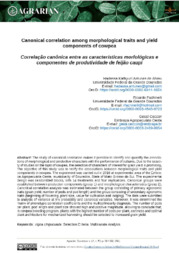Canonical correlation among morphological traits and yield components of cowpea.
Canonical correlation among morphological traits and yield components of cowpea.
Autoria: ABREU, H. K. A. de; FACHINELLI, R.; CECCON, G.
Resumo: The study of canonical correlation makes it possible to identify and quantify the associa-tions of morphological and productive characters with the performance of cultures. Due to the scarci-ty of studies on the topic of cowpea, the selection of characters of interest for grain yield is promising. The objective of this study was to verify the associations between morphological traits and yield components in cowpea. The experiment was carried out in 2016 at experimental area of the Embra-pa Agropecuária Oeste, municipality of Dourados, State of Mato Grosso do Sul. The experimental design was randomized blocks, with 14 treatments and four replications. Canonical groups were established between production components (group 1) and morphological characteristics (group 2). Canonical correlation analysis was estimated between the group consisting of primary agronomic traits (grain yield, number of pods and pod length) and the group consisting of secondary agronomic traits (beginning of flowering, plant size, value for cultivation and lodging). The data were submitted to analysis of variance at 5% probability and canonical variables. Moreover, it was determined the matrix of phenotypic correlation coefficients and the multicollinearity diagnosis. The number of pods per plant, pod length and plant size showed high and positive magnitude, allowing to conclude that, in cowpea breeding program, plants with the highest number of pods per plant, earliness and optimal plant architecture for mechanized harvesting should be selected to increased grain yield
Ano de publicação: 2021
Tipo de publicação: Artigo de periódico
Unidade: Embrapa Agropecuária Oeste
Palavras-chave: Caracteres morfológicos, Caracteres produtivos, Feijão caupi
Observações
1 - Por padrão são exibidas publicações dos últimos 20 anos. Para encontrar publicações mais antigas, configure o filtro ano de publicação, colocando o ano a partir do qual você deseja encontrar publicações. O filtro está na coluna da esquerda na busca acima.
2 - Para ler algumas publicações da Embrapa (apenas as que estão em formato ePub), é necessário ter, no celular ou computador, um desses softwares gratuitos. Sistemas Android: Google Play Livros; IOS: iBooks; Windows e Linux: software Calibre.
Acesse outras publicações
Acesse a Base de Dados da Pesquisa Agropecuária (BDPA) para consultar o acervo completo das bibliotecas da Embrapa.

